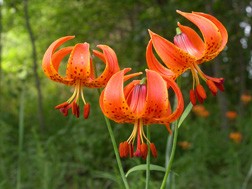Michigan Lily
- Share
- Tweet
- Pin
- Share

Roy admiring a patch of the rare Michigan Lilies.
Charlotte and I, along with our good friend, Kevin Swagel, had a magical and purely serendipitous experience six years ago along a seldom-traveled back road south of Sturgeon Bay. It was the state and federal government’s yearly June Breeding Bird Survey that Charlotte and I began volunteering for 39 years ago that led to the wonderful discovery.
The 24.5-mile route began in rural farmland north of Luxemburg in northern Kewaunee County and ended in the Little Sturgeon region in southwestern Door County. Our goals included seeing and identifying by song as many bird species and individuals as we could from each stop in a specified time and at specified distances apart. On this particular day we had invited Kevin, outstanding birder and botanist, to accompany us simply because we had such fond memories of the many times we had run the route.
It was sharp-eyed Kevin who spotted the patch of lilies growing in a ditch about 15 feet from the edge of the quiet country road. Much to our surprise, they turned out to be the rather rare Michigan Lily, very uncommon and widely scattered in our state. Around 60 years had gone by since I had last seen this species, so I had good reason to rejoice.

Michigan Lilies in various stages of development.
Our discovery of the Michigan Lilies six years ago revealed about 110 plants, around 4.5 feet tall, growing in the patch. At least half of the flowers were still in bud, which gave us the opportunity to examine and photograph the several different phases of their growth. This once-in-a-lifetime, needle-in-a-haystack discovery lured us to return several times in future years, including just recently. Fortunately, these lilies have eluded cattle and deer – both known to relish the plants – to this point, as well as people who have become quite famous for their digging (stealing) and transplanting.
True to form, the leaves of the Michigan Lily are whorled at intervals around the stem, each of the showy blossoms is between 2.5 to 3 inches across, the six tepals flare outward and then strongly backward toward the base of the blossom, and the inner surfaces of the tepals exhibit numerous brownish-purple dots especially toward the throat of the blossom. By the way, it is when the petals and sepals of a flower appear to be identical that some botanists call them tepals (TEA-pals). The habitat in which these plants appear to be thriving is in rich soil, is cool, moist and also partly shaded for most of the day.
We are extremely fussy about sharing this location with others for the simple reason that we want this tiny isolated flower garden, this virtual personal shrine, to remain intact so that it will still be there when we return the following year to admire and to relish it to the extreme.
It was in early July of 1945 when I was a sophomore in high school that I came upon a small patch of Michigan Lilies growing along the right of way of the Kewaunee, Green Bay & Western railroad tracks bordering the Kewaunee River west of town. The striking feature that immediately captured my attention was the downward-hanging blossoms with their upward-turned petals.
When I described them to my dad, he told me they were Turk’s-cap Lilies, and that was good enough for me. It so happened that he grew both the Eurasian Day Lilies and Tiger Lilies in his huge flower garden and was quite familiar with the lily group.

Michigan Lilies at their peak of bloom.
Early to mid-July is lily time, the garden variety as well as the wild. The commercial growers and lily breeders have had great success in developing new and dazzling forms of both the large and showy Tiger Lily and the more common Day Lily – upward of over 45,000 different kinds. There is little wonder that these plants have become such great favorites of gardeners today.
The orange Wood Lily of the wild is strongly spotted like the garden-grown Tiger Lily. The easily observed difference between the two is that the leaves of the Wood Lily are whorled at intervals around the stem, while the leaves of the Tiger Lily alternate along the stem. Another feature of the Tiger Lily are the small dark bulblets in the axils of the leaves. Many Tiger Lilies also resemble the Turk’s-cap Lily in that their flowers droop downward and their petals are reflexed strongly backward. Again, the flowers of the Wood Lily face upward.
The true wild Turk’s-cap Lily, Lilium superbum, is a more southern plant, can reach heights of six feet, its anthers are longer than on the Michigan Lily, and it has stamens more strongly exerted from the throat of the blossoms. Plant propagators have taken hold of the wild Turk’s-cap Lily, modified it in some cases, duplicated it by the thousands, and sold it far and wide, making it a highly sought-after garden plant.

A Michigan Lily blossom just about to open.
In that the recurved blossoms of the Michigan and Turk’s-cap Lilies make it very difficult for perching insects to get to the anthers, it is usually insects such as the Sphinx and the Clearwing Hummingbird Moths, highly adept at hovering, that do much of the required pollinating.
The very abundant reddish-yellow Day Lilies growing throughout the countryside now, and often marking old unoccupied homesteads, were introduced and naturalized from Eurasia many years ago. Surprisingly, they are actually considered an invasive in some parts of the country. Generally the blossoms are unspotted and their long, bright green, grass-like leaves immediately set them apart from our native Wood and Michigan Lilies, both which have spotted blossoms and whorled leaves.
Coincidentally, I learned that the famous Lily Tomlin was born in Detroit, Mich. in 1939. I can only wonder if the spectacular Michigan Lily is also one of her favorite wildflowers – as it ours!

